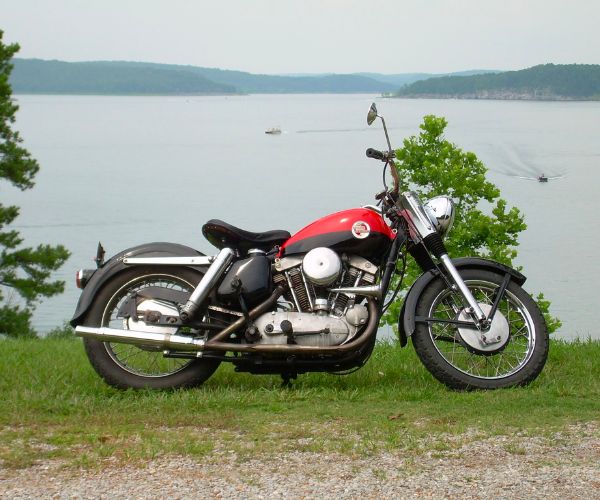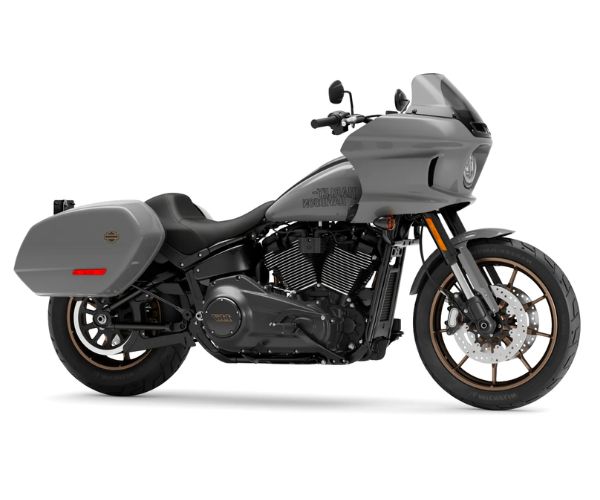When it comes to Harley Davidson motorcycles, you will have heard the terms ‘hardtail’ and ‘Softail’ thrown around. This is because Harley motorcycles fit into these two categories and are defined by them.
This article will explain the difference between a hardtail and a softail, so you know exactly what you are getting into.
What is the difference between a hardtail and softail Harley Davidson motorcycle?
The fundamental difference between a hardtail and softail Harley Davidson motorcycle is that a hardtail frame is one rigid piece with front suspension and a direct connection to the rear wheels. There is no rear suspension.
A softail motorcycle consists of two pieces, the main frame and a mini subframe that holds the rear suspension separately.
The softail chassis was introduced by Harley in 1984, and since then, it has become the most popular body type for the manufacturer.
The additional mini frame to carry the rear suspension makes the ride much smoother and more comfortable. As most HDs are cruisers, riders spend long hours in the saddle covering many miles; comfort is king.
When Harley introduced the softail frame, it was designed to conceal the rear suspension underneath, so it resembled the classic hardtail silhouette that Harley fans were used to and appreciated.
Hardtail motorcycles
The first Harley Davidson motorcycle, or technically motor-bicycle, was completed in 1903, and by 1905 their first official motorcycle was in production.
Right up until 1984, HD motorcycles were hardtails. They consisted of an engine, frame, and front forks for suspension. They sold incredibly well and were capable machines, as 90,000 units were produced for WWII alone.
Hardtail Harleys are still very popular among classic bike enthusiasts and those involved in the custom motorcycle scene.
Hardtails give a very distinctive ride. You feel every bump, crack and change in the road surface. It all gets transferred up the rigid body directly to the rider.
Those that love riding hardtails will tell you it is a more authentic riding experience, more traditional, and captures the true essence of what riding is all about; you have a direct connection to the road underneath you.
However, these people must have a strong spine and aren’t worried about causing long-term damage (unlike me). The ride can be jarring, and hardtail riders have been known to be thrown off balance by bumps and winding up in accidents.
Pros:
- Authentic, traditional riding experience connecting you to the road
- Classic line from the rear axle to the gas tank of the frame rails, which gives the streamlined style many riders love
- Cheaper to produce than softail frames thanks to the one-piece frame
- Easier to repair and cheaper than softails
- Slight cornering advantage at speed over softails
Cons:
- Uncomfortable
- Changes in the road surface and bumps can cause the rider to be displaced and lose control in extreme situations (usually at speed)
- Not suited for longer rides
Softail motorcycles
The key for Harley to introduce their new softail frame was to ensure it kept the line of the hardtail so the classic HD silhouette wasn’t lost in a new design, as the fear was they would lose their audience.
So Bill Davis, Harley rider and engineer from St Louis, set to work on a new design that would comprise of two pieces for the end goal of a smoother, more comfortable ride.
The result was a main frame, a swingarm, and dual shocks hidden by the frame and engine block. The two pieces of the frame are connected by a pivot joint near the motorcycle’s seat with a cantilever rear end (of a triangular assembly) attached.
The clever construction with hidden components managed to sustain the hardtail line that was so important.
The additional rear suspension gave the rider a much smoother overall ride, creating opportunities for longer rides in comfort. A motorcycle built with a softail design also handles much better, soaking in the bumps in the road instead of being hit by them, causing the bike to wobble.
Pros:
- Much more comfortable
- Better handling
- Still consistent with traditional Harley styling
- Longer rides are easier to take part in
Cons:
- Slightly more expensive to produce
- Lose some connection to the road at the rear of the bike
Which is more popular: hardtails or softails?
Since the release of the Softail motorcycle in 1984, they have become the most popular Harley Davidson design thanks to their increased comfort and handling advantages.
HD no longer produce hardtail frames; all of their current lineup consists of bikes with rear suspension.
However, a thriving custom and classic bike scene still carry on the hardtail tradition, with many custom shops offering hardtail bolt-on kits for various Harley models.
These are very popular with riders looking to build modern bobbers and choppers.
Most popular hardtails

Some of the most popular hardtail Harley models include:
- 1936 EL Knucklehead – Awesome classic HD, the last motorcycle that the Davidson brothers designed together as a team
- 1948 FL Hydra-Glide – Nicknamed the Panhead and featured new telescopic front forks
- Pre-1984 Sportsters – I am a big fan of the Harley Ironhead engine and am on the hunt for the perfect Ironhead Sportster. While some love these bikes as they are and will restore them, others will use these as a basis for a bobber/chop build
- Popular modern softail bikes that some owners use bolt-on hardtail kits include the Sportster models and Street Bobs
Most popular softails

It is harder to pinpoint the most popular softail models as that is all HD’s lineup currently consists of and has done for many years; however, here are some of my favorites.
- 1965 Electra-Glide – First big touring model using a Panhead engine and was fitted with a swingarm and rear suspension for added comfort
- 1984 FXST Softail – First year of the Evolution engine and the all-new Softail frame
- Softail Slim and Softail Standard – These two have the same power but have slightly different dimensions to suit riders of varying sizes
- Fatboy – Popular in Hollywood, it is beefy, chromed out, and turns heads; think Sylvester Stallone, Arnold Schwarzenegger, Kid Rock, Cher, and Ludacris
- Low Rider S – A very popular design and, in my opinion, is one of the best-looking HD’s ever produced
Final Thoughts
There it is all you need to know about hardtail and softail Harleys. All you need to remember is that hardtails are built of one piece, and you feel everything on the road, while softails are two pieces, and you have rear suspension for extra comfort.
Image credit
Jeff Bowles, CC BY 2.0, via Wikimedia Commons